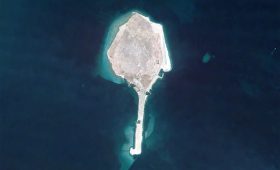Introduction to Vardzia
Vardzia, located in the picturesque landscapes of Georgia, is an extraordinary cave monastery that has fascinated travelers for centuries. Carved into the cliffs of the Erusheti Mountain, this site is part of the Vardzia Historical–Architectural Museum-Reserve. It stands as a testament to Georgia’s rich history and spiritual heritage, offering visitors a unique blend of history, spirituality, and natural beauty.
Historical Significance
The origins of Vardzia date back to the reign of Giorgi III (1156–1184), who initiated the construction of the first cave dwellings. The site was further developed by his successor, Queen Tamar, who expanded the complex to include the Church of the Dormition, additional dwellings, and a sophisticated irrigation system. Vardzia served as a refuge for monks and a strategic stronghold against invasions, with the capacity to shelter up to 20,000 people during attacks.
Despite escaping Mongol invasions, a devastating earthquake in 1283 destroyed much of the complex. However, a monastic community persisted until the site was sacked by the Persians in 1551. After the Ottoman occupation in 1578, the site was abandoned. It wasn’t until the 19th century, following the Treaty of Adrianople, that life returned to Vardzia. Today, it is a working monastery with approximately 15 monks residing in the caves.
Architectural Wonders
Vardzia’s architectural design is remarkable, featuring:
- Carved Caves: The monastery is carved directly into the cliff face, with a network of rooms and corridors.
- Church of the Dormition: The main church, adorned with frescoes from the 12th century, showcases the artistic styles of the era.
- Frescoes: These intricate wall paintings depict religious themes and figures from Georgian history.
- Defensive Structures: The complex was fortified with walls and hidden tunnels, providing protection during invasions.
Visiting Vardzia: What to Expect
Visiting Vardzia is a journey through history and breathtaking landscapes. As you approach, the sight of the monastery built into the cliffs is awe-inspiring. The atmosphere is serene, offering a peaceful escape from daily life.
The complex is extensive and can take several hours to explore. Key highlights include:
- The Grand Entrance: A large archway marks the entrance to the heart of the monastery.
- Cave Living Quarters: Explore the various rooms that provide insight into medieval monastic life.
- The Bell Tower: Climb to the top for panoramic views of the surrounding landscape.
- Monastic Cells: Discover the small cells where monks lived, offering stunning views of the Mtkvari River.
Best Time to Visit
The ideal time to visit Vardzia is during the spring (April to June) and autumn (September to October) months, when the weather is mild and conducive to exploration. Summer can be hot, while winter may bring snow, potentially limiting access to some areas.
How to Get There
Reaching Vardzia from Tbilisi, Georgia’s capital, can be an adventure. Consider the following options:
- By Car: Renting a car allows you to explore scenic routes at your leisure. The drive takes approximately 2.5 to 3 hours.
- By Marshrutka: From Akhaltsikhe, marshrutkas run to Vardzia several times a day, taking about 1.5 hours.
- Guided Tours: Many tour companies offer day trips to Vardzia from Tbilisi, providing a convenient option for visitors.
Local Transportation
Once in the region, local transportation options are limited. Taxis are available for hire in Aspindza, and some visitors choose to hike to Vardzia, enjoying the well-marked trails and stunning views.
Exploring the Surrounding Area
The area around Vardzia is rich in natural beauty and cultural landmarks. Nearby attractions include:
- Aspindza: A nearby town offering a glimpse into local life with small shops and cafes.
- Rabati Castle: A restored medieval castle located about 30 kilometers from Vardzia, showcasing Georgian architecture.
- Khertvisi Fortress: Dating back to the 10th century, this fortress is another remarkable historical site nearby.
- Natural Parks: The surrounding area is home to numerous hiking trails and parks, perfect for nature enthusiasts.
Practical Travel Tips
To make the most of your visit to Vardzia, consider the following tips:
- Wear Comfortable Shoes: The terrain can be uneven, so sturdy footwear is essential for exploring the caves and trails.
- Bring Water and Snacks: Facilities on-site are limited, so it’s wise to carry your refreshments.
- Respect the Site: As a historical and religious site, it’s important to be respectful and follow any guidelines provided by staff.
- Photography: While photography is allowed, be mindful of other visitors and the sacredness of certain areas.
Local Cuisine
While visiting Vardzia, indulge in the local Georgian cuisine, including:
- Khachapuri: A delicious cheese-filled bread, a staple in Georgian cuisine.
- Khinkali: Juicy dumplings filled with meat or vegetables, best enjoyed with a sprinkle of black pepper.
- Churchkhela: A traditional Georgian sweet made from nuts and grape juice, perfect for a quick snack.
Summary of Key Facts
- Vardzia is a 12th-century cave monastery located in Georgia.
- It was developed by Queen Tamar and is part of the Vardzia Historical–Architectural Museum-Reserve.
- The complex includes over 600 rooms, churches, and living quarters carved into the cliff face.
- The best time to visit is during spring (April to June) and autumn (September to October).
- Access can be achieved by car, marshrutka, or guided tours from Tbilisi.
- Local transportation options include taxis and walking trails.
- Nearby attractions include Aspindza, Rabati Castle, and Khertvisi Fortress.
- Local cuisine features dishes like khachapuri, khinkali, and churchkhela.
Conclusion
Vardzia offers a journey through history, spirituality, and stunning natural beauty. Whether you’re a history enthusiast, a spiritual seeker, or a traveler in search of breathtaking views, Vardzia promises an enriching experience. Pack your bags, grab your camera, and prepare to be captivated by this incredible site in Georgia!




